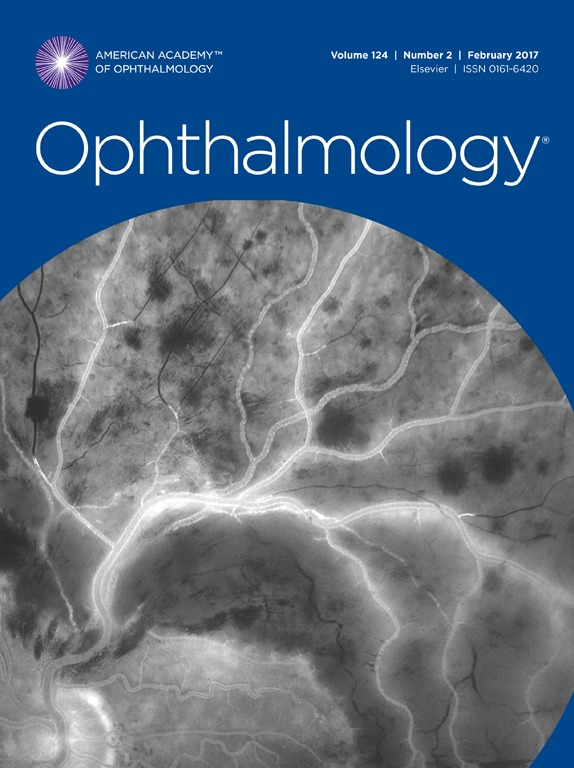Associations between School-Based Vision Program Outcomes and School Characteristics in 410 Schools
IF 13.1
1区 医学
Q1 OPHTHALMOLOGY
引用次数: 0
Abstract
Purpose
School-based vision programs (SBVPs) deliver care to students at school, addressing disparities in access to pediatric vision care. We aimed to evaluate the associations between SBVP outcomes and school-level characteristics.
Design
Retrospective cross-sectional data analysis.
Participants
Public schools with at least 50 SBVP-enrolled students 5 to 22 years old with complete demographic data. Schools with less than 60% of total grade levels served by the SBVP were excluded, creating a sample of 410 schools.
Methods
Vision screening and eye examination data were extracted from 2016-2022 Helen Keller International’s United States Vision Program dataset. Individual student data were aggregated to characterize each school’s SBVP outcomes and were analyzed with schools’ publicly available socioeconomic and demographic data (student body race and ethnicity composition, proportion of students qualifying for free and reduced-price meals [FARM], and proportion of English language learners). Fractional regression models were used to understand associations between SBVP outcomes and school characteristics.
Main Outcome Measures
SBVP outcomes were rates of vision screening failure, prescriptions for eyeglasses, and community eye care referral among each school’s SBVP-enrolled students.
Results
We evaluated 151 elementary schools (36.8%), 155 middle schools (37.8%), and 104 high schools (25.4%), with a median proportion of students qualifying for FARM of 87.4% and a plurality of Hispanic students in 61.0% of schools. Median rates of vision screening failure, eyeglasses prescription, and referral were 38.4%, 25.2%, and 5.4%, respectively. High schools were associated with increased screening failure and eyeglasses prescription rates and a decrease in referral rate compared with elementary schools. In multivariable analysis, each 10% increase in proportion of students qualifying for FARM was associated with a 2.6% (95% confidence interval [CI]: 1.54%–3.65%), 1.8% (95% CI, 0.87%–2.74%), and 0.86% (95% CI, 0.36%–1.36%) increase in screening failure, prescriptions for eyeglasses, and referral rates, respectively.
Conclusions
Significant vision care demand exists among public schools, especially those with students from lower socioeconomic backgrounds. School-based vision programs are important in improving pediatric vision care access. Our findings demonstrated opportunities to allocate personnel and equipment resources according to schools’ anticipated needs, thus maximizing SBVPs’ impact.
Financial Disclosure(s)
Proprietary or commercial disclosure may be found in the Footnotes and Disclosures at the end of this article.
在 410 所学校中,校本视觉计划成果与学校特征之间的关联。
目的:校本视力保健项目(SBVPs)直接为在校学生提供视力保健服务,有助于解决儿童视力保健机会不均等的问题。我们旨在评估校本视力保健项目的成果与学校层面特征之间的关联:设计:回顾性横截面数据分析 参与者:至少有 50 名 5 至 22 岁学生参加 SBVP 的公立学校,并提供完整的人口统计学数据。学校视力筛查计划服务的年级总数少于 60% 的学校被排除在外,因此样本为 410 所学校:从海伦-凯勒国际组织的美国视力计划数据集中提取了 2016 年至 2022 年的视力筛查和眼科检查数据。对学生个人数据进行汇总,以描述每所学校的 SBVP 结果,并与学校公开的社会经济和人口统计数据(学生的种族和民族构成、有资格享受免费和减价膳食的学生比例 [FARM%],以及英语语言学习者的比例)进行分析。描述性统计汇总了 SBVP 的结果。利用分数回归模型了解 SBVP 结果与学校特征之间的关联:SBVP 的结果是每所学校参加 SBVP 的学生中视力筛查失败率、眼镜配戴率和社区眼科转诊率:我们对 151 所小学(36.8%)、155 所初中(37.8%)和 104 所高中(25.4%)进行了评估,这些学校的中位数 FARM% 为 87.4%,61.0% 的学校有大量西班牙裔学生。视力筛查失败率、眼镜处方率和转诊率的总体中位数分别为 38.4%、25.2% 和 5.4%。与小学相比,高中的筛查失败率和眼镜配戴率均有所上升,而转诊率则有所下降。在多变量分析中,FARM% 每增加 10%,筛查失败率、眼镜处方率和转诊率分别增加 2.6%(95% 置信区间 [CI]:1.54-3.65)、1.8%(CI:0.87-2.74)和 0.86%(CI:0.36-1.36):公立学校对视力保健的需求很大,尤其是那些学生来自社会经济背景较差的学校。校外视力保健项目对于缩小这些人群在获得儿科视力保健服务方面的差距非常重要。我们的研究结果表明,可以根据学校的预期需求来分配项目的人员和设备资源,从而最大限度地发挥 SBVPs 在提供儿科视力保健方面的作用。
本文章由计算机程序翻译,如有差异,请以英文原文为准。
求助全文
约1分钟内获得全文
求助全文
来源期刊

Ophthalmology
医学-眼科学
CiteScore
22.30
自引率
3.60%
发文量
412
审稿时长
18 days
期刊介绍:
The journal Ophthalmology, from the American Academy of Ophthalmology, contributes to society by publishing research in clinical and basic science related to vision.It upholds excellence through unbiased peer-review, fostering innovation, promoting discovery, and encouraging lifelong learning.
 求助内容:
求助内容: 应助结果提醒方式:
应助结果提醒方式:


